Non-Destructive Evaluation of Material Stiffness beneath Pile Foundations Tip Using Harmonic Wavelet Transform
Abstract
1. Introduction
2. Characteristics of Wave Propagation in the Pile
3. Determination of Subsoil Stiffness Beneath a Pile Foundation Using Harmonic Wavelet Transform
3.1. Harmonic Wavelet Transform
3.2. Determination of Subsoil Stiffness Beneath a Pile Foundation
- Apply the impact force on the surface of the pile head and measure the wave signal in the time domain (Figure 2).
- Compute the harmonic wavelet transform of the wave signal to identify the wave groups (Figure 5a). Each wave group corresponds to local maxima in the time–frequency (T-F) magnitude map (indicated by red circles in Figure 5a). The first wave group represents the incident wave; subsequent wave groups correspond to the reflected waves (Figure 5a).
- Select a certain frequency, fselect, within the frequency range where the second wave group exhibits sufficient magnitude. Determine tg1, tg2, tg3, etc., based on the magnitude of the harmonic wavelet coefficient corresponding to fselect Hz. Here, the magnitude and phase of the harmonic wavelet coefficient corresponding to fselect Hz represent the magnitude and phase of the single-frequency component, fselect Hz, of the wave propagating inside the pile. The time points, tg, correspond to local maximum magnitudes for each wave group (Figure 5b).
- Determine the local maximum magnitude corresponding to each wave group. M1max, M2max, M3max, … are local maximum magnitudes measured at tg1, tg2, tg3, … corresponding to wave groups 1, 2, 3, … (Figure 5b).
- Evaluate the magnitude ratio between the first (incident) and second (the first reflected) wave groups as follows:
- 6.
- Determine the phases θ1, θ2, θ3, … from the phase of the harmonic wavelet coefficient corresponding to fselect. These phases correspond to tg1, tg2, tg3, … (Figure 5c). Evaluate the phase difference θdiff between the consecutive wave groups.
- 7.
- Determine the velocity ratio () using the magnitude ratio from Step (5) and phase difference from Step (6), as shown in Figure 6.
- 8.
- Evaluate the wave velocity (i.e., stiffness) of the material under the pile bottom as follows:
4. Verification Using Numerical Simulation
4.1. Numerical Simulation Modeling
4.2. Numerical Simulation Results
4.3. Discussion
5. Conclusions
Author Contributions
Funding
Data Availability Statement
Acknowledgments
Conflicts of Interest
References
- Das, B.M. Principles of Foundation Engineering, 7th ed.; Cengage Learning India: Noida Uttar Pradesh, India, 2010. [Google Scholar]
- Rausche, F.; Likins, G.; Kung, S.R. Pile integrity testing and analysis. In Application of Stress-Wave Theory to Piles; Routledge: London, UK, 2022; pp. 613–617. [Google Scholar]
- Li, D.Q.; Zhang, L.M.; Tang, W.H. Reliability evaluation of cross-hole sonic logging for bored pile integrity. J. Geotech. Geoenviron. Eng. 2005, 131, 1130–1138. [Google Scholar] [CrossRef]
- Ly, C.; Eng, C.; Heng, M.Y.; Yos, P. Concrete Pile Defect Identification: Insights from Cross-Hole Sonic Logging and High Strain Dynamic Pile Test. IOP Conf. Ser. Earth Environ. Sci. 2022, 1117, 012059. [Google Scholar] [CrossRef]
- Lu, Z.T.; Zhi, L.W.; Dong, J.L. A study on the application of the parallel seismic method in pile testing. Soil Dyn. Earthq. Eng. 2013, 55, 255–262. [Google Scholar] [CrossRef]
- Sun, Q.; Elshafie, M.; Banker, C.; Fisher, A.; Schooling, J.; Rui, Y. Thermal integrity testing of cast in situ piles: An alternative interpretation approach. Struct. Health Monit. 2021, 20, 2493–2512. [Google Scholar] [CrossRef]
- Piscsalko, G.; Cotton, D.; Belardo, D.; Likins, G. Using Thermal Integrity Profiling to Confirm the Structural Integrity of foundation applications. In Proceedings of the International Foundations Congress and Equipment Expo 2015, San Antonio, TX, USA, 17–21 March 2015; pp. 2607–2616. [Google Scholar]
- Johnson, K.R. Analyzing thermal integrity profiling data for drilled shaft evaluation. DFI J.-J. Deep Found. Inst. 2016, 10, 25–33. [Google Scholar] [CrossRef]
- Ambrosini, D.; Ezeberry, J. Long Piles Integrity Trough Impact Echo Technique. Mec. Comput. 2005, 24, 651–670. [Google Scholar]
- Kim, H.J.; Mission, J.L.; Dinoy, P.R.; Kim, H.S.; Park, T.W. Guidelines for impact echo test signal interpretation based on wavelet packet transform for the detection of pile defects. Appl. Sci. 2020, 10, 2633. [Google Scholar] [CrossRef]
- Amir, J.M. Single-tube ultrasonic testing of pile integrity. In Deep Foundations 2002: An International Perspective on Theory, Design, Construction, and Performance; American Society of Civil Engineers: Reston, VA, USA, 2002; pp. 836–850. [Google Scholar]
- Cui, S.H.; Liu, H.W.; Maghoul, P. Pile length estimation based on guided wave theory and dispersion analysis for reuse of foundations. Int. J. Solids Struct. 2023, 283, 112486. [Google Scholar] [CrossRef]
- Rashidyan, S.; Tang-tat, N.; Arup, M. Study of the effect of sensor location on sonic echo/impulse response testing in timber piles. AUT J. Civ. Eng. 2020, 4, 473–486. [Google Scholar]
- Rashidyan, S.; Tang-tat, N.; Arup, M. Bridge foundation depth estimation using sonic echo test. In Experimental and Applied Mechanics, Volume 4: Proceedings of the 2015 Annual Conference on Experimental and Applied Mechanics, Costa Mesa, CA, USA, 8–11 June 2015; Springer International Publishing: Berlin/Heidelberg, Germany, 2016. [Google Scholar]
- Liao, S.T.; Chin, K.H.; Wang, C.Y. Sonic echo and impulse response tests for length evaluation of soil nails in various bonding mediums. Can. Geotech. J. 2008, 45, 1025–1035. [Google Scholar] [CrossRef]
- Cunha, R.P.; Cordeiro, A.F.; Cárdenas, J.C.R. Comparison of integrity and echo tests in the assessment of defects in pile foundations. Balt. Piling 2013, 165–169. [Google Scholar]
- Lozovsky, I.N.; Zhostkov, R.A.; Churkin, A.A. Numerical simulation of ultrasonic pile integrity testing. Russ. J. Nondestruct. Test. 2020, 56, 1–11. [Google Scholar] [CrossRef]
- Finno, R.J.; Gassman, S.L. Impulse response evaluation of drilled shafts. J. Geotech. Geoenviron. Eng. 1998, 124, 965–975. [Google Scholar] [CrossRef]
- Liao, S.T.; Roesset, J.M. Dynamic response of intact piles to impulse loads. Int. J. Numer. Anal. Methods Geomech. 1997, 21, 255–275. [Google Scholar] [CrossRef]
- Davis, A.G. The nondestructive impulse response test in North America: 1985–2001. NDT&E Int. 2003, 36, 185–193. [Google Scholar]
- Finno, R.J.; Popovics, J.S.; Hanifah, A.A.; Kath, W.L.; Chao, H.C.; Hu, Y.H. Guided wave interpretation of surface reflection techniques for deep foundations. Ital. Geotech. J. 2001, 35, 76–91. [Google Scholar]
- Yang, Y.; Li, G.; Luo, N.; Cao, X. Testing of Structural Integrity of U-Shaped Sheet Pile in Canal Engineering Using Ground Penetrating Radar. Appl. Sci. 2022, 12, 11558. [Google Scholar] [CrossRef]
- Lee, J.S.; Song, J.U.; Hong, W.T.; Yu, J.D. Application of time domain reflectometer for detecting necking defects in bored piles. NDT&E Int. 2018, 100, 132–141. [Google Scholar]
- Baker, C.N., Jr.; Drumright, E.E.; Mensah, F.D.; Parikh, G.; Ealy, C.D. Use of nondestructive testing to evaluate defects in drilled shafts: Results of FHWA research. Transp. Res. Rec. 1991, 1331, 28–35. [Google Scholar]
- Park, H.C.; Kim, D.S. Non-Destructive Pile Integrity Test Using HWAW Method. Key Eng. Mater. 2006, 321, 363–366. [Google Scholar] [CrossRef]
- Park, H.C.; Kim, D.S.; Cho, S.E. Development of non-distructive pile soundness test using HWAW method. J. Korean Geotech. Soc. 2008, 234, 13–23. [Google Scholar]
- Liu, J.L.; Wang, S.F.; Zheng, J.Y.; Chang, C.M.; Wei, X.J.; Ren, W.X. Time–Frequency Signal Processing for Integrity Assessment and Damage Localization of Concrete Piles. Int. J. Struct. Stab. Dyn. 2020, 20, 2050020. [Google Scholar] [CrossRef]
- Ni, S.H.; Yang, Y.Z.; Tsai, P.H.; Chou, W.H. Evaluation of pile defects using complex continuous wavelet transform analysis. NDT&E Int. 2017, 87, 50–59. [Google Scholar]
- Goble, G.G. The analysis of pile driving-A state-of-the-art. In Proceedings of the International Conference on the Application of Stress-Wave Theory to Piles, Stockholm, Sweden, 4–5 June 1980. [Google Scholar]
- Linkis, G.E.; Rausche, F.; Thendean, G.; Svinkin, M. CAPWAP Correlation Studies. In Proceedings of the 5th International Conference on the Application of Stress-Wave Theory to Piles, Orlando, FL, USA, 11–13 September 1996. [Google Scholar]
- Lee, J.S.; Seo, M.J.; Park, G.W.; Kim, D.H.; Kim, Y.D. Research on the Development of Rational Dynamic Load Test Bearing Capacity Analysis Methods and Guidelines; LH Land and Housing Research Institute: Daejeon, Republic of Korea, 2020. [Google Scholar]
- Park, J.B. A comparative study on the bearing capacity of dynamic load test and static load test of PHC bored Pile. J. Korean Geo-Environ. Soc. 2017, 18, 19–31. [Google Scholar]
- Wang, C.; Han, J.T. Effect of preloaded micropile on the foundation underpinning by centrifuge experiments. Géotech. Lett. 2021, 11, 10–15. [Google Scholar] [CrossRef]
- Newland, D.E. Wavelet analysis of vibration, Part 1: Theory. J. Vib. Acoust. Trans. ASME 1994, 116, 409–416. [Google Scholar] [CrossRef]
- Newland, D.E. Wavelet analysis of vibration, Part 2: Wavelet maps. J. Vib. Acoust. Trans. ASME 1994, 116, 417–425. [Google Scholar] [CrossRef]
- Jung, B.S.; Lee, J.H.; Kweon, G.C. Application of Impact Resonance Test to the Determination of Elastic Modulus and Damping Ratio of Concrete. J. Korea Concr. Inst. 2010, 22, 625–632. (In Korean) [Google Scholar] [CrossRef][Green Version]
- Graff, K.F. Wave Motion in Elastic Solids; Dover Publications: Mineola, NY, USA, 1991. [Google Scholar]
- Boashash, B. Estimating and interpreting the instantaneous frequency of a signal. I. Fundamentals. Proc. IEEE 1992, 80, 520–538. [Google Scholar] [CrossRef]
- Hwang, H.J.; Park, H.C. Evaluation of condition of gravel ballast layer on high-speed railway using surface wave method based on harmonic wavelet analysis of waves. NDT&E Int. 2010, 68, 78–687. [Google Scholar]
- Park, H.C.; Kim, D.S. Evaluation of dispersive phase and group velocities using harmonic wavelet transform. NDT&E Int. 2001, 34, 457–467. [Google Scholar]
- Villiappan, S.; Muriti, V. Finite Element Constraints in the Analysis of Wave Propagation Problem; UNICV Report No. R-218; The University of New South Wales, The School of Civil Engineering: Sydney, Australia, 1984. [Google Scholar]
- Saenger, E.H.; Gold, N.; Shapiro, S.A. Modeling the propagation of elastic waves using a modified finite-difference grid. Wave Motion 2000, 31, 77–92. [Google Scholar] [CrossRef]
- Zerwer, A.; Cascante, G.; Hutchinson, J. Parameter estimation in finite element simulations of Rayleigh waves. J. Geotech. Geoenviron. Eng. 2002, 128, 250–261. [Google Scholar] [CrossRef]
- A Study on Site-Specific Seismic Design Response Spectrum; Ministry of Construction and Transportation: Seoul, Republic of Korea, 1997.

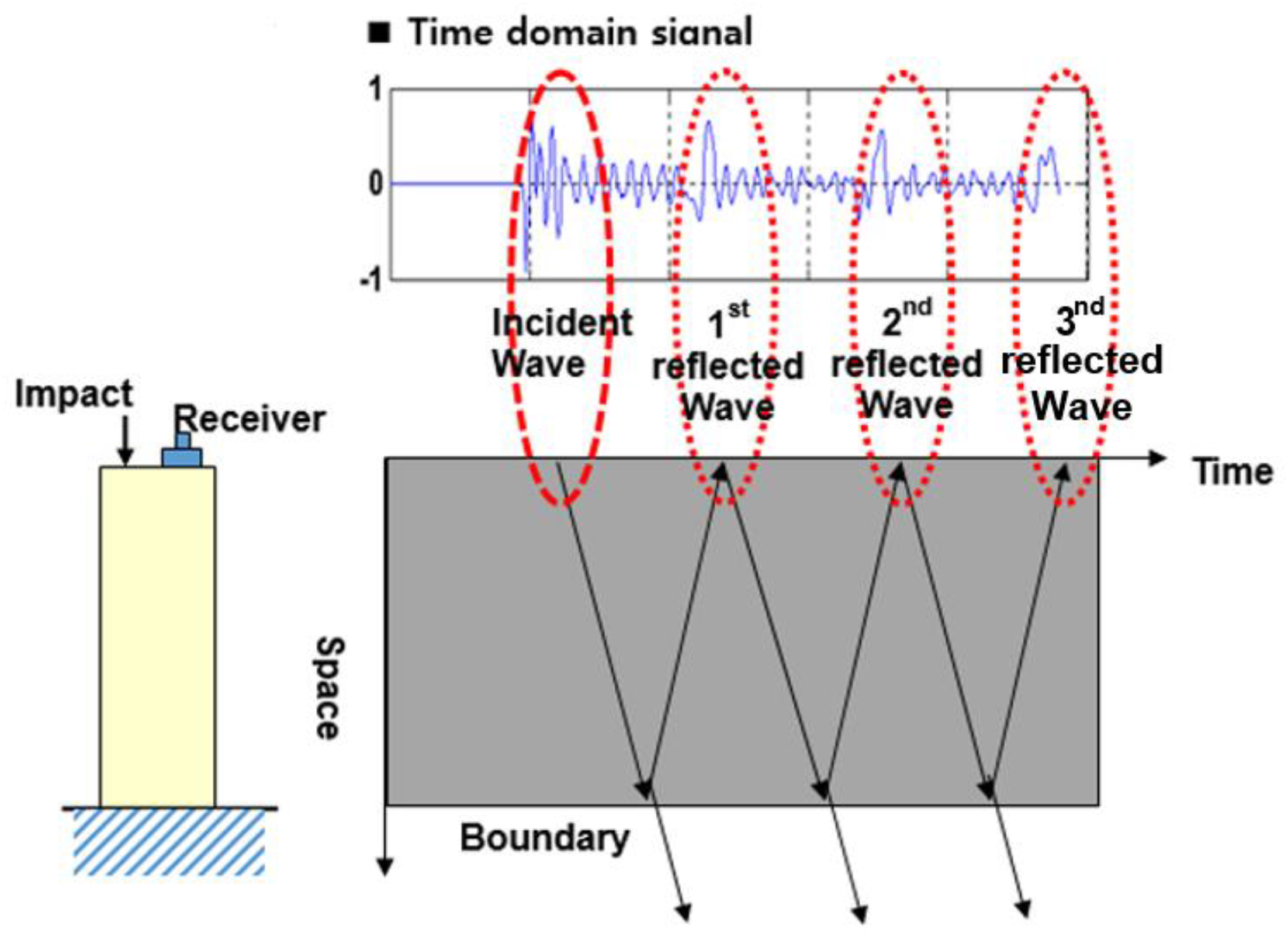
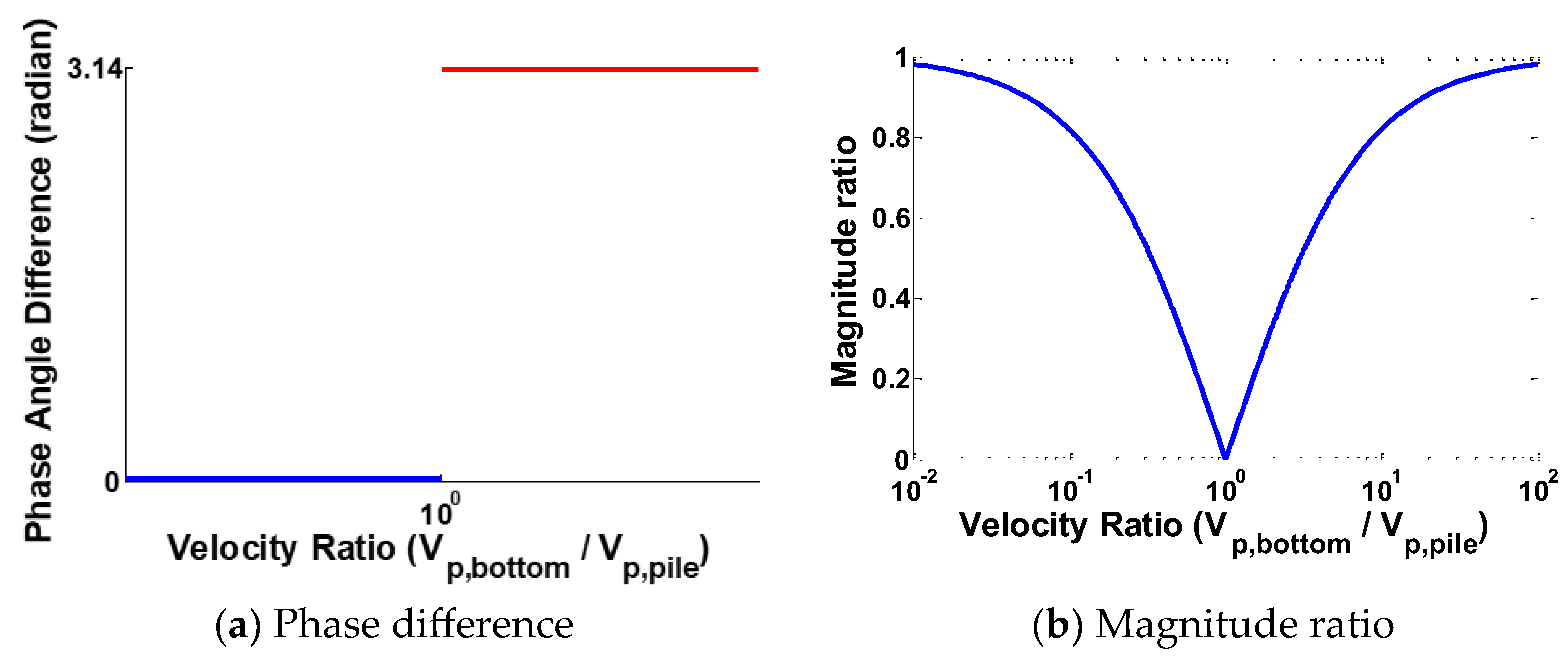
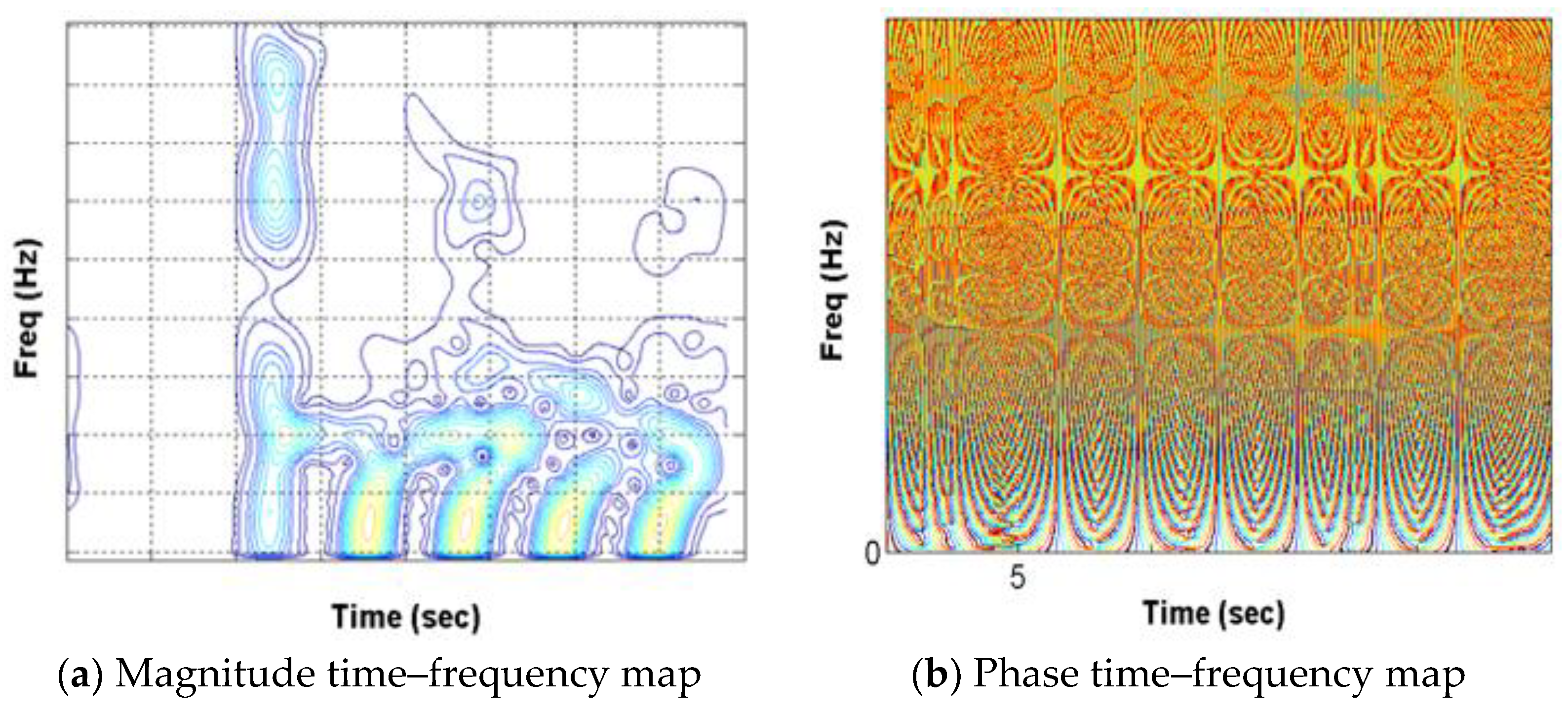
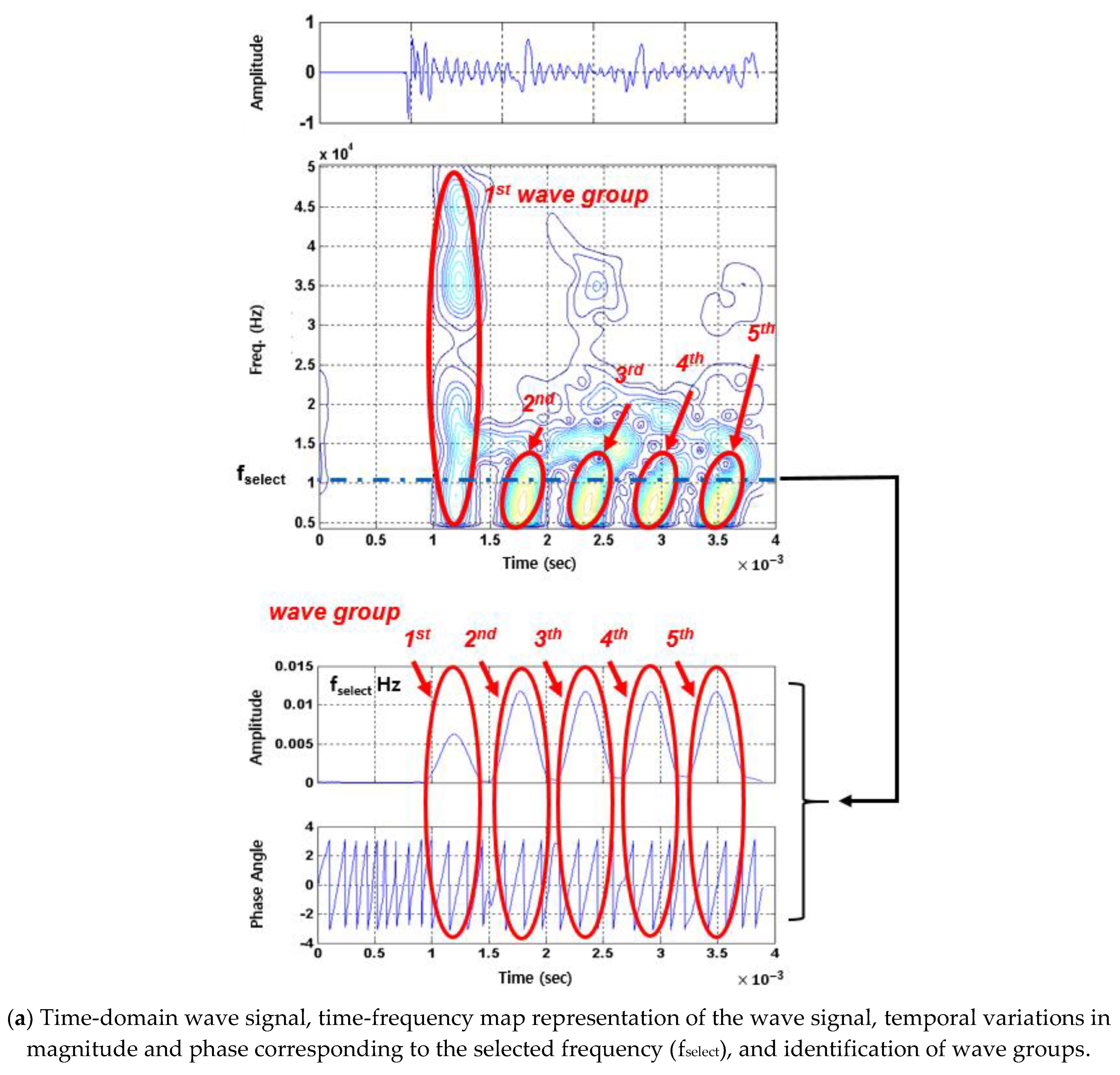
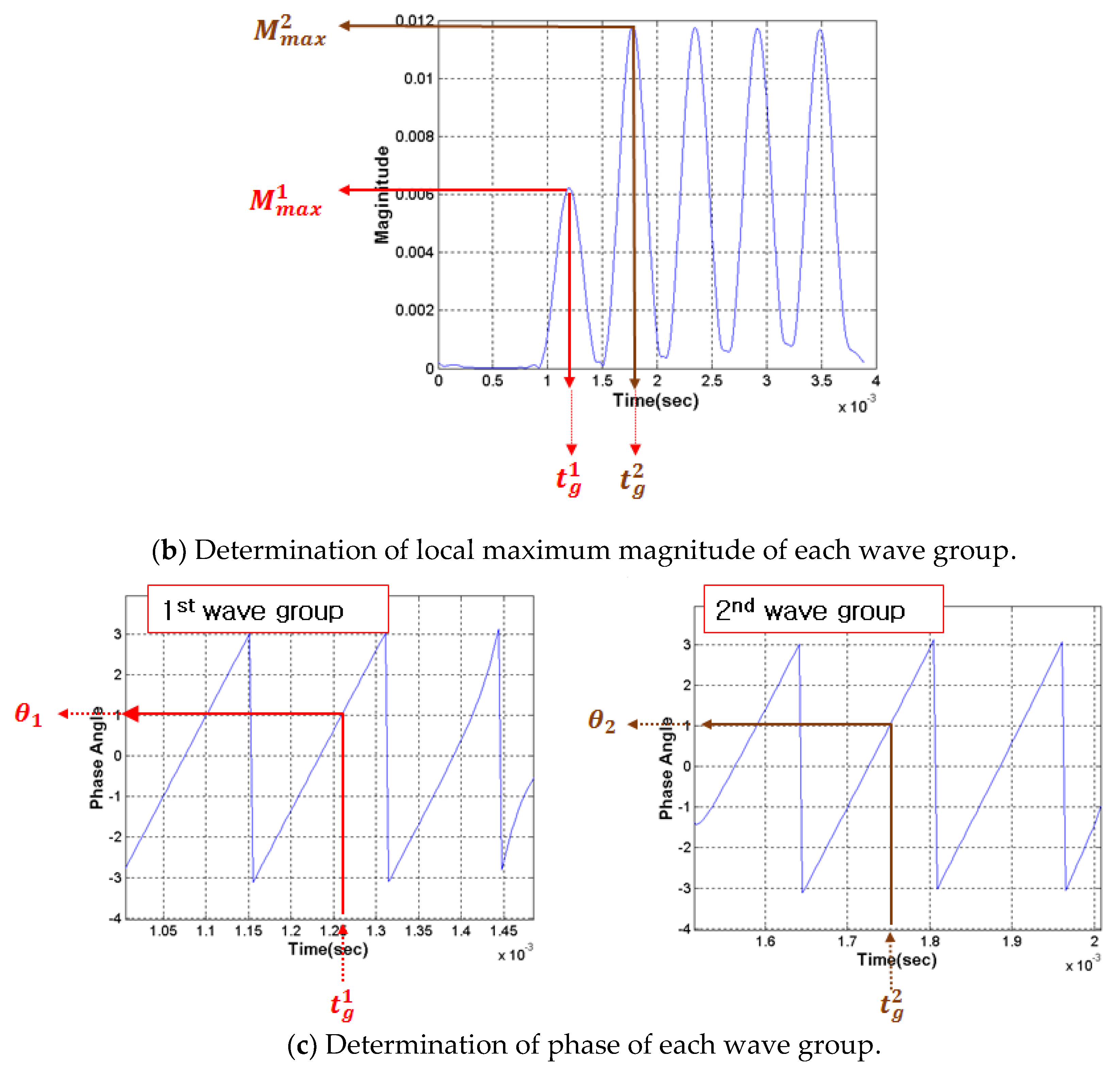
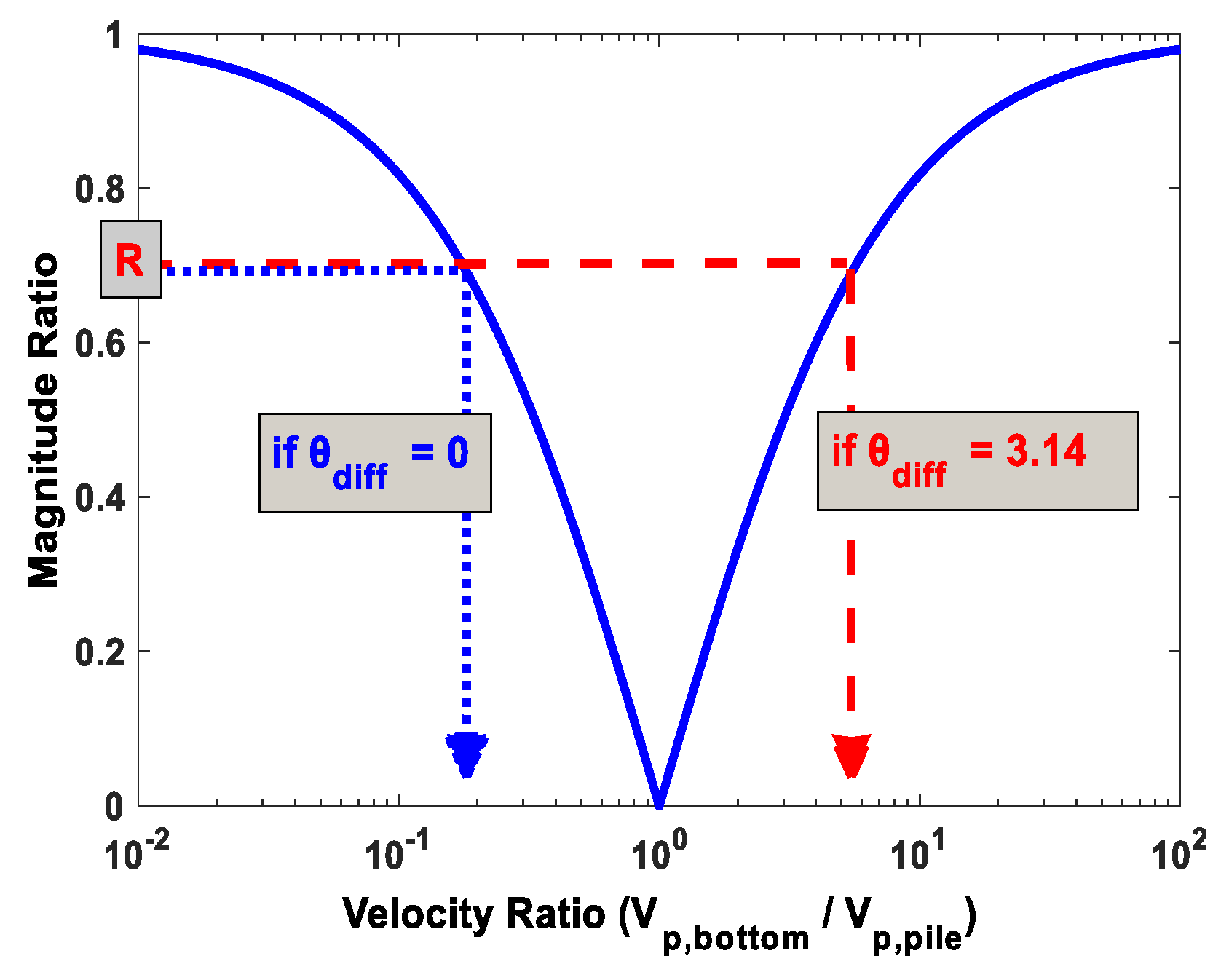

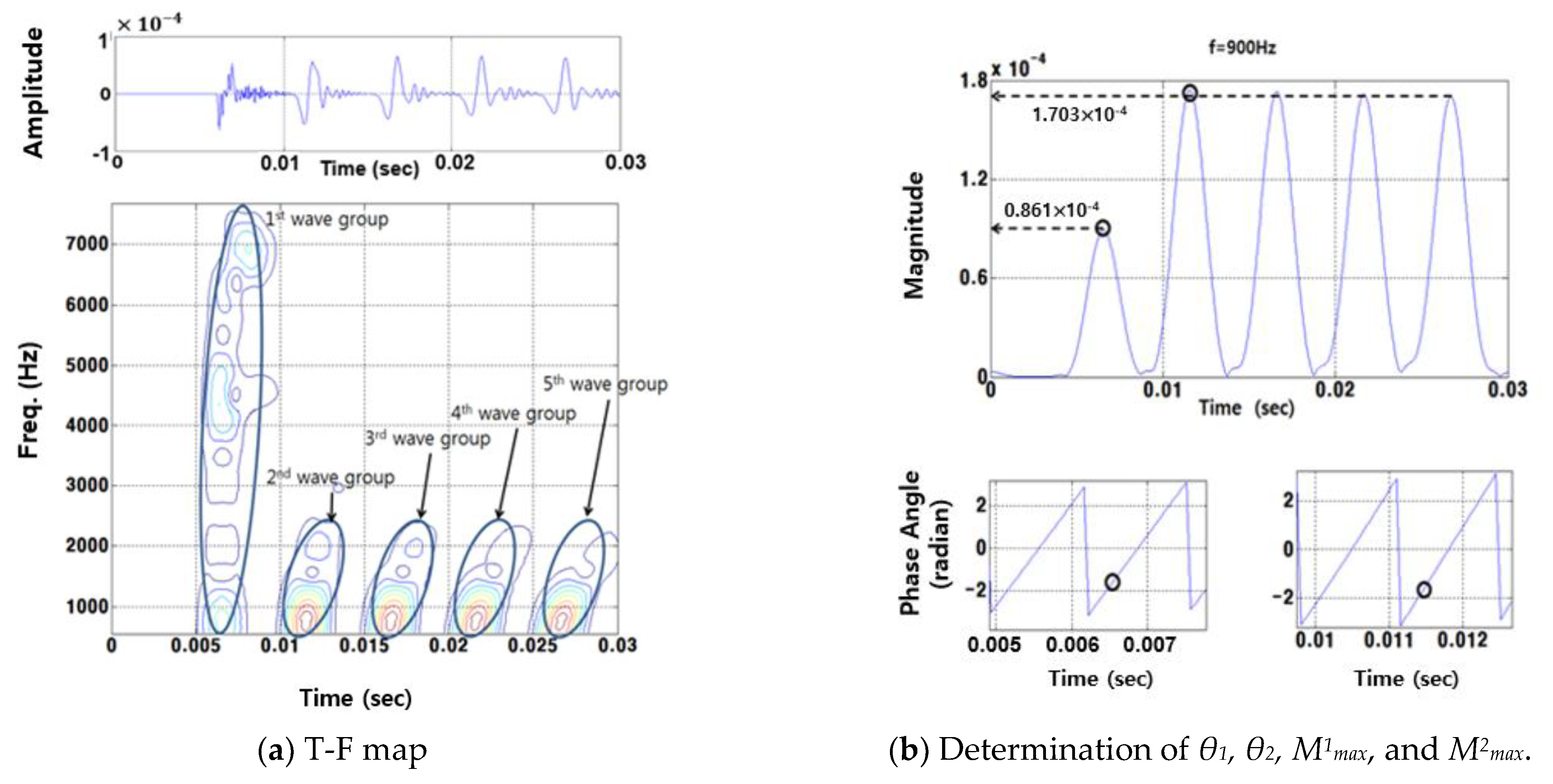

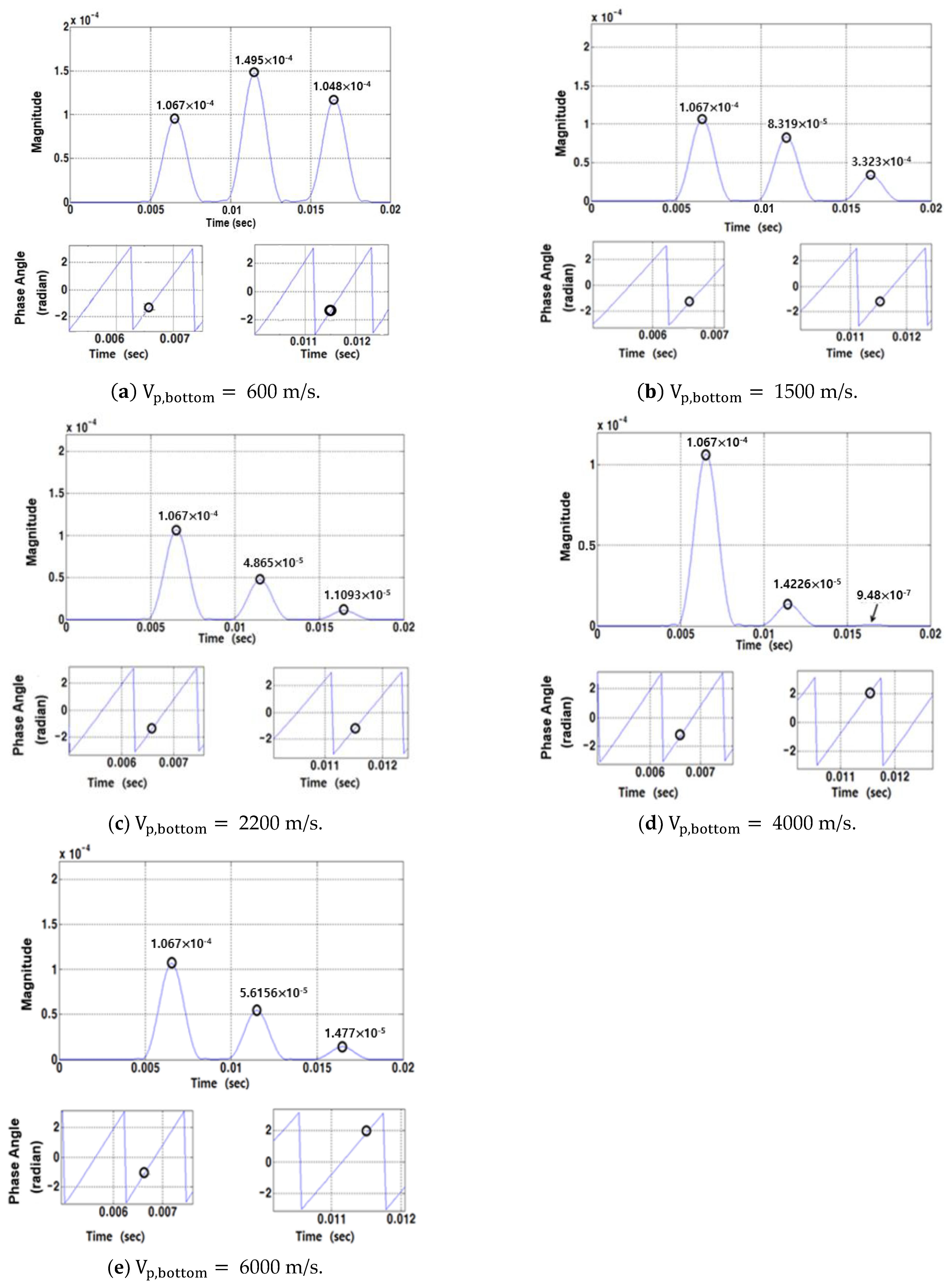
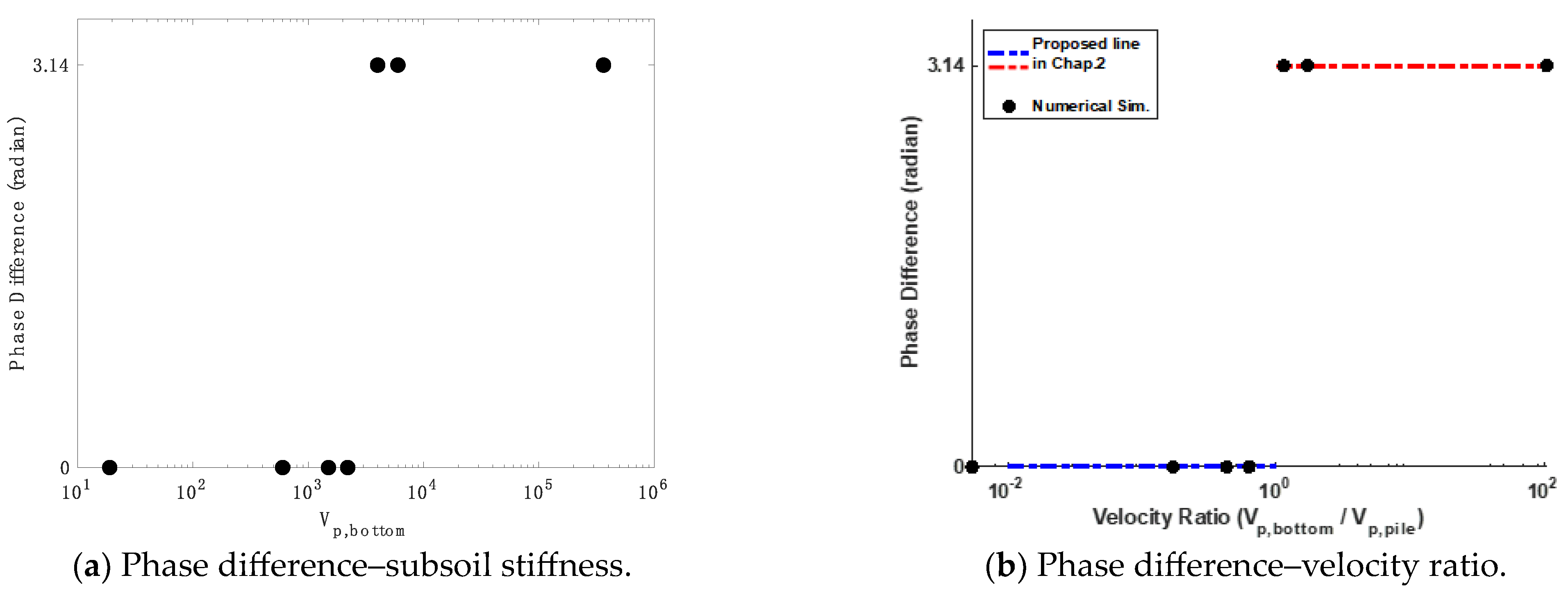
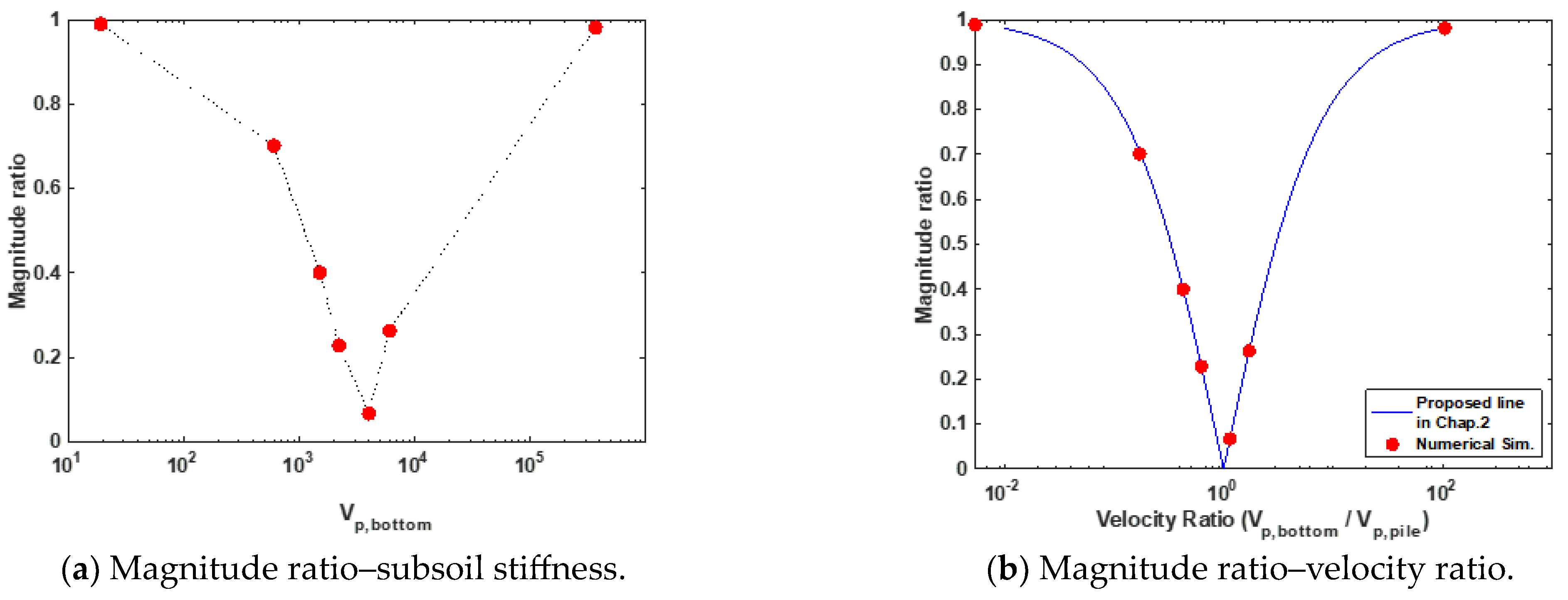

| P-Wave Velocity (m/s) | Poisson’s Ratio and Unit Weight (kg/m3) | ||||
|---|---|---|---|---|---|
| Pile | Surrounding Soil | Bottom Soil (or Rock) | Pile | Surrounding Soil | Bottom Soil (or Rock) |
| 3500 | 150 | Free boundary condition | 0.2 and 2200 kg/m3 | 0.25 and 1800 kg/m3 | 0.25 and 1950 kg/m3 |
| 600 | |||||
| 1500 | |||||
| 2200 | |||||
| 4000 | |||||
| 6000 | |||||
| Fixed boundary condition | |||||
| Calculated Value | ||||
|---|---|---|---|---|
| R | (Radian) | (m/s) | ||
| Free boundary condition | 0.989 | 0 | 0.010 | 19 |
| Fixed boundary condition | 0.981 | 3.14 | 104 | 364,000 |
| Boundary Type | (m/s) | Calculated Value | |||
|---|---|---|---|---|---|
| R | (Radian) | (m/s) | |||
| Softer boundary | 600 | 0.701 | 0 | 0.175 | 615 |
| 1500 | 0.400 | 0 | 0.429 | 1500 | |
| 2200 | 0.228 | 0 | 0.629 | 2200 | |
| Stiffer boundary | 4000 | 0.067 | 3.14 | 1.144 | 4003 |
| 6000 | 0.263 | 3.14 | 1.714 | 5998 | |
Disclaimer/Publisher’s Note: The statements, opinions and data contained in all publications are solely those of the individual author(s) and contributor(s) and not of MDPI and/or the editor(s). MDPI and/or the editor(s) disclaim responsibility for any injury to people or property resulting from any ideas, methods, instructions or products referred to in the content. |
© 2024 by the authors. Licensee MDPI, Basel, Switzerland. This article is an open access article distributed under the terms and conditions of the Creative Commons Attribution (CC BY) license (https://creativecommons.org/licenses/by/4.0/).
Share and Cite
Oh, H.-J.; Park, J.-H.; Park, H.-C. Non-Destructive Evaluation of Material Stiffness beneath Pile Foundations Tip Using Harmonic Wavelet Transform. Buildings 2024, 14, 511. https://doi.org/10.3390/buildings14020511
Oh H-J, Park J-H, Park H-C. Non-Destructive Evaluation of Material Stiffness beneath Pile Foundations Tip Using Harmonic Wavelet Transform. Buildings. 2024; 14(2):511. https://doi.org/10.3390/buildings14020511
Chicago/Turabian StyleOh, Hyun-Ju, Jung-Hoon Park, and Hyung-Choon Park. 2024. "Non-Destructive Evaluation of Material Stiffness beneath Pile Foundations Tip Using Harmonic Wavelet Transform" Buildings 14, no. 2: 511. https://doi.org/10.3390/buildings14020511
APA StyleOh, H.-J., Park, J.-H., & Park, H.-C. (2024). Non-Destructive Evaluation of Material Stiffness beneath Pile Foundations Tip Using Harmonic Wavelet Transform. Buildings, 14(2), 511. https://doi.org/10.3390/buildings14020511





